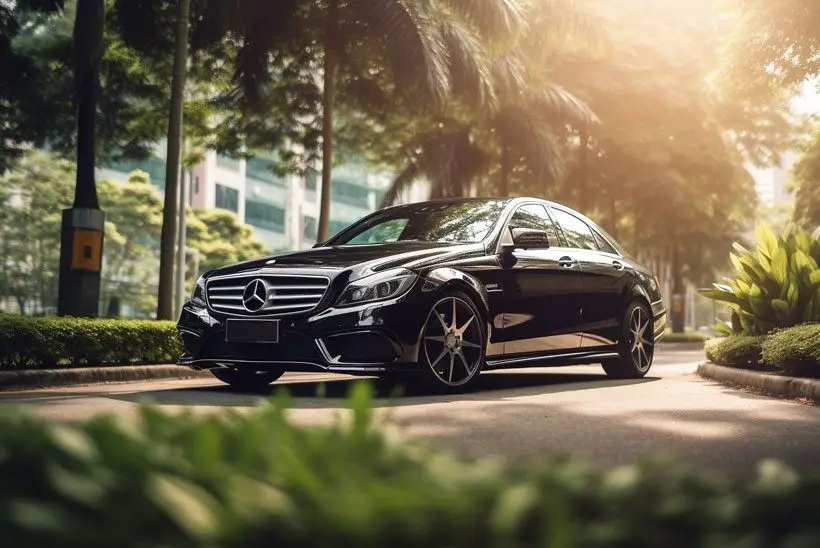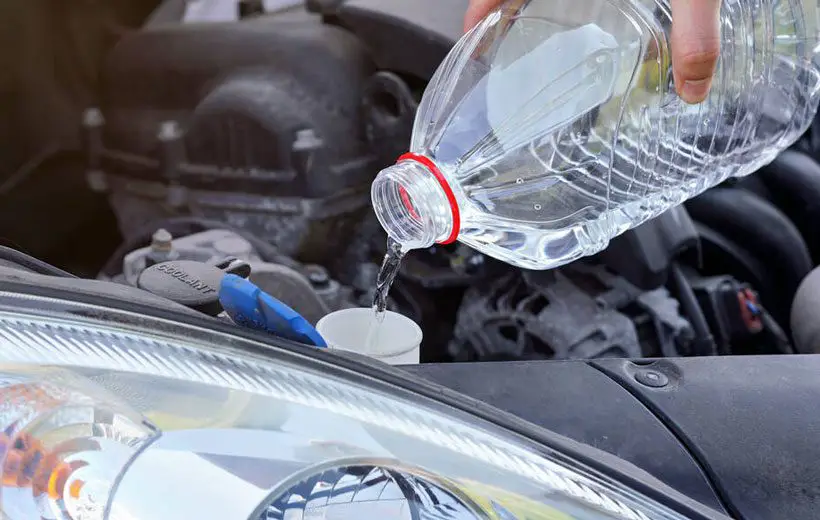There’s a never-ending debate on whether it’s good to use distilled water as engine coolant. While the answer isn’t a simple yes or no, there are both good and bad sides of using distilled water to cool car engines.
Using distilled water as a coolant can sometimes be a solution when it’s an emergency and you have no other option to cool your car down. But this is only temporary. A chemically formulated coolant can transfer heat well, has higher boiling and lower freezing point, and is better for the engine as well.
In this guide, we’ll see why coolants are used in the first place. We’ll then talk about different coolant types and the pros and cons of using distilled water as a coolant.
The Importance of Coolant in Preventing Engine Overheating

To understand the importance of coolant, we first have to know what consists of a car’s cooling system. There are 4 things in the system.
- Radiator
- Cooling Fan
- Thermostat and
- Overflow tank.
Coolant first goes from the coolant tank to the engine through small holes around the engine. It then heats up and goes inside the radiator, which gets blown with the cooling fan to let the liquid cool down.
The thermostat controls the coolant’s flow. It blocks and opens the pipeline depending on whether the engine is overheated or underheated.
Without coolant, engines would overheat and start melting. In fact, engines

would break down before they’d even melt. Coolant helps keep engine temperature down and keeps the car’s inside temperature under control.
Different Types of Coolants for Different Types of Engines

Let’s briefly talk about different coolant types.
Fully-Formulated Coolant
These coolants contain both antifreeze and coolants combined in single packages. They prevent cavitation (vapor bubbles), rust, and corrosion. This is used by both small and large vehicles.
Extended-Life Coolant
This is similar to fully formulated coolants. These types of coolants are designed for longer use. Mainly, heavy-duty trucks use extended-life coolants.
Low-Silicate Coolant
These coolants use a mixture of silicone and oxygen to create silicates. They coat the metal parts of the engine to protect the engine’s walls. The silicates help to increase the fluid’s boiling point and decrease its freezing point.
Pros of Using Distilled Water as Coolant

If you use distilled water as a coolant, you will get the following benefits.
Free of Impurities
Impurities present in natural and processed water can cause the buildup of salt and other chemicals used to process water in plants. These chemicals will wear the engine’s parts and radiator away. These also may cause blockage in the radiator’s pipes in the long run.
Potentially Causes Less Buildup in the Engine
Unlike tap water, there are fewer minerals present in distilled water. As a result, using distilled or softened water will result in far less scaling and mineral buildup in the engine.
Cons of Using Distilled Water as Coolant

Along with benefits, using distilled water as a coolant is also disadvantageous in different ways. They are as follows.
Lacks Necessary Additives to Prevent Rust and Corrosion
Commercially available coolants come premixed with additives that help prevent corrosion and rust inside the engine. While distilled or softened water is purer than tap water, they’ll still cause rust formation on the engine walls. By nature, water is corrosive to metal and known to cause rust growth.
Not as Effective Heat Transfer as Proper Coolant
Water turns into steam at 212 degrees Fahrenheit and freezes at 0 degrees Fahrenheit. As water turns into steam, it starts to have less contact with the engine’s metal and, as a result, lowers the heat transfer.
Coolants, on the other hand, have far higher boiling and lower freezing points. They can withstand high temperatures while maintaining optimal heat transfer.
Alternatives to Using Distilled Water as Coolant
When distilled water isn’t typically recommended, you should look for alternative coolants. The following two are the common coolants that are used as natural coolants.

Ethylene Glycol Coolant
Ethylene Glycol is a commonly used coolant compound. It’s an organic, alcohol-based antifreeze. Thus, it has a low freezing point of about 10 degrees Celsius.
When it’s used with water, its freezing point drops even below to keep the coolant in liquid form in colder weather.
Propylene Glycol Coolant
Propylene Glycol is similar to Ethylene Glycol but far less toxic than its Ethylene counterpart. It’s less viscous than Ethylene and takes longer to distribute heat, making it less effective than the other.
Preventive Maintenance Tips for Avoiding Coolant-Related Problems
Let’s talk about a few methods you can follow to avoid possible coolant-related issues. Following these tips will ensure your car engine lasts long and stays under a safe working temperature.

Regular Maintenance
It’s recommended to change a car’s radiator’s coolant once every 30,000 miles or every 2 years if you use a silicone based coolant. Or, in case you use an extended drain coolant, you should change that once every 100,000 miles or every 5 years. This has to be done in a specific process known as flush and refill. Let’s talk about how to do that right, step by step, below.
- Step 1: Place your car on a level surface. Locate the radiator tank. Open the radiator valve right underneath the radiator tank, on the bottom of the car. Now, drain the old radiator fluid completely.
- Step 2: Through the radiator’s inlet valve Fill the radiator tank with distilled water. This step will clean the old coolant off of the radiator tank and cooling pipes.
- Step 3: Drive the car for about 10-15 minutes to let water inside the tank settle down. The vibration from driving causes the air bubbles to come up.
- Step 4: Drain water from the radiator tank. Mix 50% coolant with 50% water. Pour the mixture into the tank through the radiator’s inlet pipe.
- Step 5: Drive the car again for about 10-15 minutes. This time it is to let the coolant settle down well inside the tank.
- Step 6: Drive the car again for about 10-15 minutes. This time it is to let the coolant settle down well in the reserve.
- Step 7: After driving, some air bubbles will come up, causing the fluid level to drop in the coolant reservoir. Top it off with more coolant.
So that’s about it. That’s the whole process.
Coolant System Checks
Checking the whole coolant system is a great way to ensure your car’s coolant and other connected parts are working well. There are several ways you can check the coolant system:

Check Pipes
Check all the pipes that the coolant passes through. The rubber material of the pipes should be able to come back into its former shape once it’s squeezed. If the rubber feels squishy, it’s time to replace the pipes.
Check Radiator Inlet Cap
Using a radiator cap pressure tester, test the pressure level of the inlet cap. If it has worn out, the cap won’t be able to hold the recommended pressure of the coolant. In that case, replace the cap.
Check Thermostat
Take the car’s thermostat out and submerge it in the coolant. Check the recommended temperature on the thermostat. Now, heat the coolant 25 degrees Fahrenheit over that thermostat’s recommended temperature and drown the thermostat in it.
The sudden temperature change should cause the thermostat to open now. Then, cool the coolant to 10 degrees Fahrenheit below that recommended temperature and again drown the thermostat. It should close at this point. If the thermostat doesn’t react to the coolant’s temperature differences, it’s time to get a new one.
Check Antifreeze’s Strength
Antifreeze is a type of chemical that lowers the cooling point of water. In simple terms: when you mix antifreeze with water, the mixture will stay in liquid form at very low temperatures. You can use a hydrometer to check your current antifreeze’s cooling point.
Monitoring Temperature Gauge
If you ever notice that the temperature gauge is showing a red light, this is a sign of an overheating engine. Open the car’s hood to see if any steam is coming from the radiator area or not, then open the radiator inlet valve and check the fluid level.
If the level is low, fill the tank up using distilled water. Then, as soon as possible, take your car to a mechanic’s garage and fill it up with new coolant.
If you’re considering using distilled water as coolant in your car, you may also want to learn more about whether you can add water to the coolant and why your coolant may be low without any visible leaks. Our article on can you add water to the coolant provides insights into when and how to add water to your car’s coolant system, as well as the importance of maintaining the proper coolant-to-water ratio. Additionally, our article on why is my coolant low but no leaks explores possible reasons for coolant loss and helps you troubleshoot the issue. These resources can help you understand the best practices for maintaining your car’s cooling system and address any concerns related to coolant levels.Conclusion
In this guide, we’ve talked about why coolants are necessary, how they work, and their types. Finally, we’ve seen the good and bad of using distilled water for this job. Hopefully, you’re less confused about using distilled water as a coolant now than you were before.
Use distilled water or softened water that’s devoid of the heavy metals. Or use a coolant that you find best considering your area’s weather. But it’s always better if you can consult a professional before picking your choice. Remember, going for a wrong choice can be damaging to your vehicle, at the end of the day.
